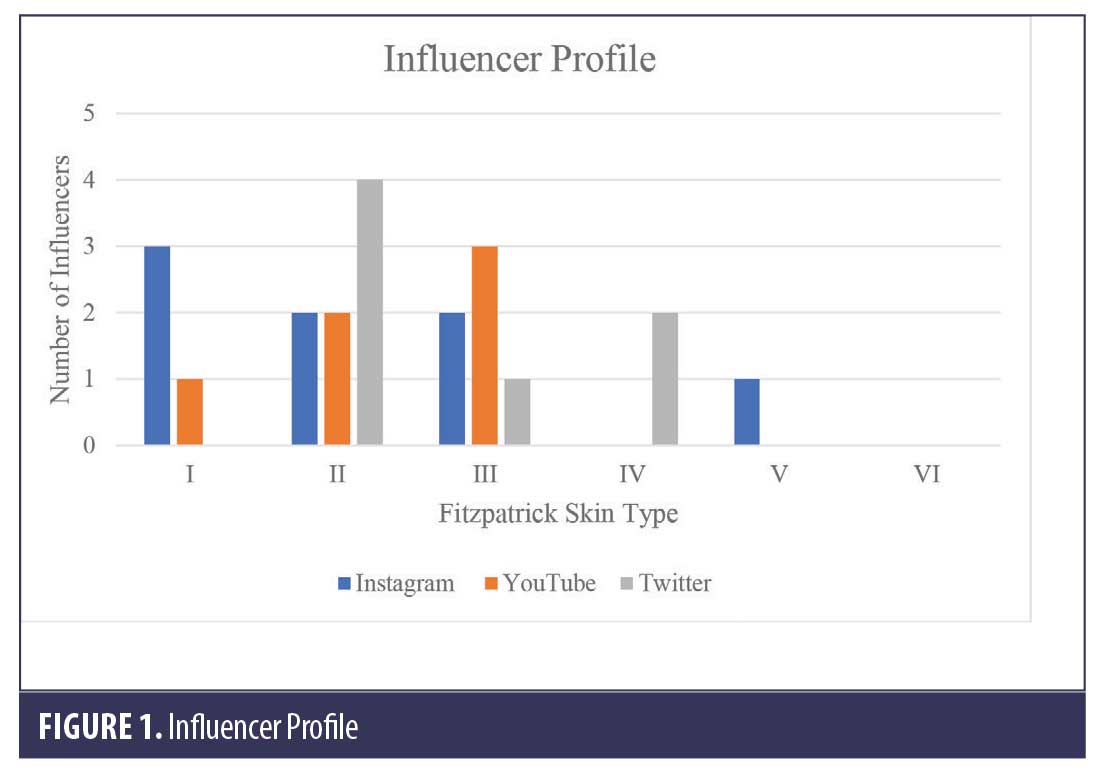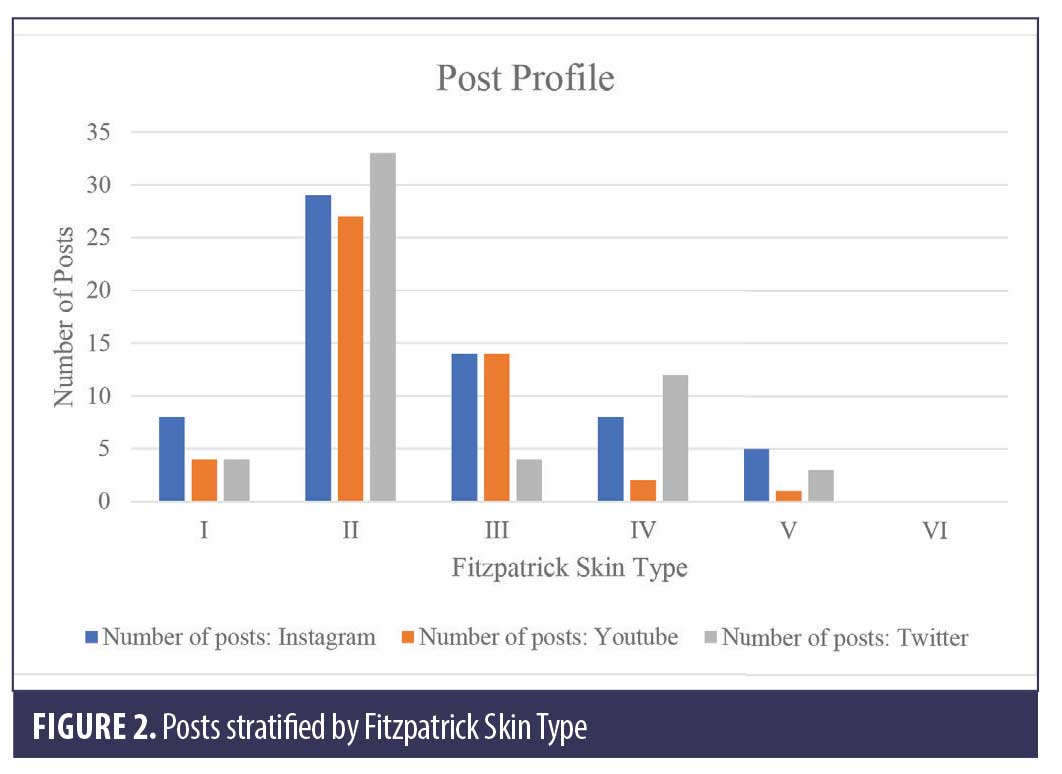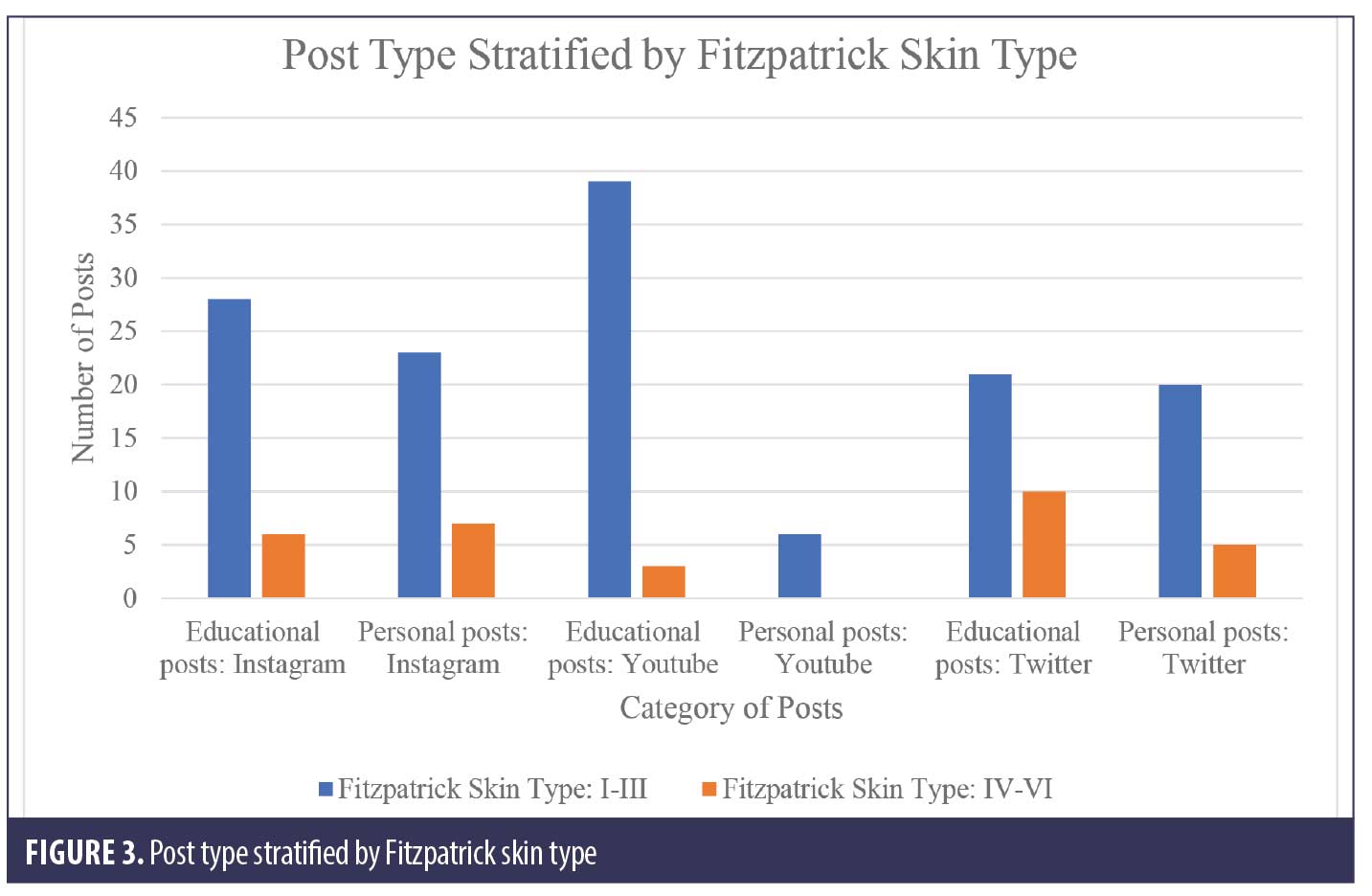 J Clin Aesthet Dermatol. 2022;15(11):40–42.
J Clin Aesthet Dermatol. 2022;15(11):40–42.
by Komal A. Paradkar, MD, and Jessica A. Kaffenberger, MD
Both authors are with The Ohio State College of Medicine in Columbus, Ohio.
ABSTRACT: Objective. Skin conditions manifest differently on darker skin tones, yet lighter skin tones are usually overrepresented in dermatology educational resources. Our aim was to explore the representation of skin tones within dermatology social media posts in 2019.
Methods. This is a retrospective review of posts made on Instagram, YouTube, and Twitter by the top 2019 dermatology social media influencers. Twenty-one accounts were included. Eight posts were randomly chosen per account and graded by the Fitzpatrick scale (I-VI).
Results. Overall, Fitzpatrick Type II was the most represented skin type (53%), while Fitzpatrick Type VI was the least represented (0%). On Instagram, 79.7 percent of posts represented light skin tones (Fitzpatrick Types I-III) and 20.3 percent represented dark skin tones (Fitzpatrick Types IV-VI). On YouTube, 93.75 percent of posts represented light skin tones and 6.25 percent represented dark skin tones. On Twitter, 73.2 percent of posts represented light skin tones and 26.8 percent represented dark skin tones.
Limitations. This study is limited by the subjective nature of assigning Fitzpatrick skin types and by only analyzing posts from dermatology social media influencers in 2019.
Conclusion. Within the analyzed posts, darker skin tones were represented less frequently than lighter skin tones; we encourage a wider range of skin tone representation within educational resources.
Keywords. skin tone, skin of color, Fitzpatrick scale, skin type, social media, Instagram, YouTube, Twitter, general dermatology, dermatology education
Skin conditions manifest differently on skin of color; yet, lighter skin tones are usually overrepresented in dermatology educational resources. When 4,146 images from medical textbooks were analyzed, lighter skin tones were overrepresented (74.5%) and darker skin tones were underrepresented (4.5%), with the remaining characterized as medium skin tones (21%).1 Another study found that dark skin tones were portrayed in only 4–19% of images in several dermatology textbooks; while a third study found that online resources showed dark skin in 22.1 percent of images and printed texts only showed darker skin color in 10.3 percent of images.2,3
Social media is an accessible, rising educational tool. In 2020, dermatology social media influencers had a median Instagram subscriber count of 109,000 with a median engagement per post of 984.4 These numbers are replicated on YouTube (28,550 and 135 respectively) and Twitter (8,910 and 6 respectively) with educational posts being the most prevalent on Instagram and YouTube, and second to personal posts on Twitter.4
While it is clear that dermatologists often use social media to provide education, it is unclear whether darker skin tones are represented on these social media accounts. When considering the underrepresentation of darker skin tones within other educational resources, we hypothesize that darker skin tones will be represented less frequently than lighter skin tones in social media posts made by top dermatology influencers.
Methods
This is a retrospective review of posts made on Instagram, YouTube, and Twitter in 2019 by the top dermatologists per social media platform as defined by Tiffany J. Sierro et al.4 Twenty-one of these influencer accounts (8 Instagram, 6 YouTube, 7 Twitter) were included. Accounts were excluded due to dissolution of the account, private settings, or less than two posts per season. Posts from all four seasons were assessed; eight posts (2 per season) were chosen from each influencer account via a random number generator, to eliminate the variable of sun exposure, for a total of 168 posts (Instagram 64, YouTube 48, Twitter 56). Posts were analyzed by Fitzpatrick Skin Type, with I-III characterized as lighter shades of skin, and IV-VI as darker shades of skin.
Repeat people in previous posts and influencers themselves were excluded. Posts were categorized into “educational” and “personal” post types. Educational posts included posts about patients, specific skin care and diseases, and procedures. Personal posts included achievements, advertisements, and reposts from other social media accounts.
Results
We analyzed posts made by the 21 most popular dermatologist social media accounts of 2019 from each of the following platforms: Instagram, YouTube, and Twitter. The dermatologist accounts included in this study are listed in Table 1.4

The influencers are from around the world, with most practicing in the United States; the majority are from New York (n=8), followed by California (n=4). The majority (n=13) of the influencers are also women. The influencers were further stratified by Fitzpatrick Skin Type (Figure 1). Across all three social media platforms, a total of four influencers were Fitzpatrick Type I, eight were Fitzpatrick Type II, six were Fitzpatrick Type III, two were Fitzpatrick Type IV, one was Fitzpatrick Type V, and no influencers were Fitzpatrick Type VI. Fitzpatrick Type II was the most common influencer skin type. Fitzpatrick Type I was the most common skin type in Instagram influencers, Fitzpatrick Type III was the most common skin type in YouTube influencers, and Fitzpatrick Type II was the most common skin type in Twitter influencers.

All posts were also stratified by Fitzpatrick skin type (Figure 2). Fitzpatrick Type II was the most commonly represented in all social media outlets (89 posts), while Fitzpatrick Type VI was the least represented skin type (0 posts).

79.7 percent (51 posts) of Instagram posts represented light skin tones and 20.3 percent (13 posts) represented dark skin tones). This reflects 6.38 light skin tone posts per influencer and 1.63 dark skin tone posts per influencer. Light skin influencers made 46 of the light skin posts and 10 of the dark skin posts (6.57 light skin posts per light skin influencer vs 1.43 dark skin posts per light skin influencer). Instagram had only one dark skin influencer who made five light skin posts and three dark skin posts for an average of five light skin posts per dark skin influencer and three dark skin posts per dark skin influencer.
93.75 percent (45 posts) of YouTube posts represented light skin tones and 6.25 percent (3 posts) represented dark skin tones. This accounts for 7.5 light skin tone posts per influencer and 0.5 dark skin tone posts per influencer. All influencers from YouTube were Fitzpatrick Types I-III, there was no dark skin tone influencer representation from this social media platform.
73.2 percent (41 posts) of Twitter posts represented light skin tones and 26.8 percent (15 posts) of posts represented dark skin tones. This accounts for 5.86 light skin tone posts per influencer and 2.14 dark skin tone posts per influencer. When this data was stratified by influencer skin tone, the results showed that 35 light skin tone posts were made by five light skin tone influencers (7 light skin tone posts per light skin tone influencer), five dark skin tone posts were made by five light skin tone influencers (1 dark skin tone post per light skin tone influencer), six light skin tone posts were made by two dark skin tone influencers (3 light skin tone posts per dark skin tone influencer) and 10 dark skin tone posts were made by two dark skin tone influencers (5 dark skin tone posts per dark skin tone influencer).
Of the total 168 posts, 63.7 percent (107 posts) were educational. By type, 53.1 percent (34 posts) of Instagram, 87.5 percent (42 posts) of YouTube, and 55.4 percent (31 posts) of Twitter posts were educational. Of all educational posts, 82.2 percent (88 posts) represented light skin tones and 17.8 percent (19 posts) represented dark skin tones. The remaining 61 posts were personal and 80.3 percent (49 posts) of these posts represented light skin tones and 19.7 percent (12 posts) represented dark skin tones.
Educational posts were more common among all three social medial platforms when compared to personal posts. Both educational and personal posts were further broken down by Fitzpatrick skin type (Figure 3). Of the 34 educational posts analyzed from Instagram, 82.4 percent (28 posts) represented light skin tones and 17.6 percent (6 posts) represented dark skin tones. Of the 30 personal posts analyzed from Instagram, 76.7 percent (23 posts) represented light skin tones and 23.3 percent (7 posts) represented dark skin tones. Of the 42 educational posts analyzed from YouTube, 92.9 percent (39 posts) represented light skin tones and 7.1 percent (3 posts) represented dark skin tones. Each of the six personal posts analyzed from YouTube represented light skin tones. Of the 31 educational posts analyzed from Twitter, 67.7 percent (21 posts) represented light skin tones and 32.3 percent (10 posts) represented dark skin tones. Of the 25 personal posts analyzed from Twitter, 80.0 percent (20 posts) represented light skin tones and 20.0 percent (5 posts) represented dark skin tones.

Discussion
Skin of color has been underrepresented in educational resources, especially in medical textbooks. Our aim was to explore the representation of skin tones within posts made by dermatology influencers who have a wide reach to the general population.
Our data indicates that darker skin tones were represented less frequently compared to lighter skin tones in the top dermatology influencer posts of 2019.
In the United States, 72 percent of people identify as Caucasian, 18.5 percent as Latino, 12.8 percent as African American, and 5.7 percent as Asian.5 While it is impossible to determine the range of Fitzpatrick Skin Types in each of these populations, it is likely that many of the social media platforms we analyzed underrepresented some of these minority groups. For instance, Fitzpatrick Type VI skin tone was not represented in any analyzed post.
Posts reflecting darker skin tones were more commonly made by influencers with darker skin. Dermatology is one of the least diverse specialties in the United States with only 3 percent of dermatologists identifying as black and 4.2 percent identifying as Hispanic.6,7 A lack of diversity of dermatologists may contribute to fewer posts reflecting darker skin tones, less educational information to patients with darker skin, and may contribute to underrepresentation of minorities pursuing dermatology.
Previous literature demonstrated that patients with darker skin tones had increased satisfaction of their care when seen at a dermatology skin of color clinic where the provider was knowledgeable about African American skin and hair.8 Thus, this underrepresentation of diverse skin tones has large implications on patient care.
More educational material reflecting darker skin types is needed and social media is an accessible platform for dermatologists to help decrease this disparity.
References
- Louie P, Wilkes R. Representations of race and skin tone in medical textbook imagery. Soc Sci Med. 2018;202:38–42.
- Ebede T, Papier A. Disparities in dermatology educational resources. J Am Acad Dermatol. 2006;55(4):687–690.
- Alvarado SM, Feng H. Representation of dark skin images of common dermatologic conditions in educational resources: A cross-sectional analysis. J Am Acad Dermatol. 2021;84(5):1427–1431.
- Sierro TJ, Young PM, Kassabian SK, et al. Dermatologists in social media: A study on top influencers, posts, and user engagement. J Am Acad Dermatol. 2020;83(5):1452–1455.
- U.S. Census Bureau; American Community Survey, 2019 American Community Survey Demographic and Housing 1-Year Estimates, Table DP05; generated by Komal Paradkar; using data.census.gov; <https://data.census.gov/cedsci/>; (10 August 2021).
- Pandya AG, Alexis AF, Berger TG, et al. Increasing racial and ethnic diversity in dermatology: A call to action. J Am Acad Dermatol. 2016;74(3):584–587.
- Lu JD, Sverdlichenko I, Siddiqi J, et al. Barriers to Diversity and Academic Promotion in Dermatology: Recommendations Moving Forward. Dermatology. 2021;237(4):489–492.
- Gorbatenko-Roth K, Prose N, Kundu RV, et al. Assessment of Black Patients’ Perception of Their Dermatology Care. JAMA Dermatol. 2019;155(10):1129.

